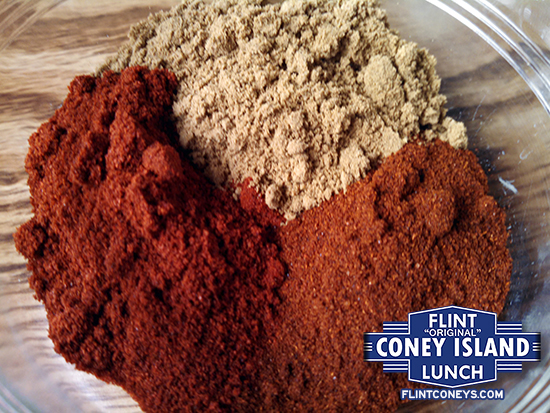
Choosing Recipe Ingredients
Flint Coney sauce is a simple thing. Its inspiration was a Macedonian Goulash that was made of beef heart and kidney, some of the most inexpensive parts of an animal. So when the sauce was developed the most commonly-availoable spices were used. Don’t worry about eotic or “pure” spices. Get what’s the most common, and that’ll be most accurate.
And just to be clear, spices generally don’t “go stale” or lose their intensity. Spices have been found that are thousands of years old and are still perfectly edible.
- Onions for Topping & Recipes – Using a sweet or savory onion for Flint Coneys is a personal choice, as restaurants seem divided over this. When using a savory onion be sure it’s the white variety, not yellow. And be sure the onions are as fresh as possible.
- Cumin – This can be labeled any number of things: Cumin, cumino, ground cumin, or ground cumin seed. This is one of the items which provides the recognizable flavor of a Flint Coney topping.
- Paprika – There are a number of different types of paprika. The type most used in Flint Coney recipes will be what’s known as a mild Spanish paprika. You can try different ones to see what the difference might be, but the stronger ones such as the sweeter Hungarian and more savory smoked paprikas will cause different results.
- Chili Powder – Use a simple generic blend. The Flint Coney shops in Flint will probably either get the Trade East Mild Chili Power from GFS, or the McCormick Chili Powder from Sysco. We use the GFS version in all the Flint Coney sauce recipes we’ve developed. Any “pure ” chili powder is going to screw up the flavor profile.
Chopping the Onions
Many people chop onions by cutting the root and top off, removing the outer skins, slicing them, then roughly chopping the slices. The technique used in commercial kitchens is far simpler, faster, and reduces the possibility of tearing-up while chopping. It also introduces a level of consistency most home cooks only see in restaurants. This is important when looking for the smaller chop seen on the coneys in older Flint Coney restaurants.
For the knife, a 6″ or 8” Chef’s knife works best. Make sure the knife is extremely sharp, as this also reduces tearing-up when cutting onions. Sharpening with a whetstone (use water, not oil, to whet the stone) and then honing with a steel gives the best edge.
- Cut the top from the onions, leaving the roots intact.
- Peel the skin off until the onions are clean and white.
- Place the trimmed onions in a sealed container (not a bag) and refrigerate at 40F for 30 minutes.
- On a cutting board, from the root of the onion, cut it in half. Lay the onion on the cut side with the top away from your cutting hand.
- With a target chop of about 1/8” square in mind, and without cutting into the root of the onion, make 2 or 3 horizontal cuts (depending on the size of the onion) from the bottom up that are parallel with the cutting board.
- Make vertical cuts from one side of the onion to the other, again not cutting through the top, 1/8” in width.
- The professional method here is to hold the non-cutting hand as a sort of “claw” with the tips of the fingers pulled in slightly from the knuckle, holding the onion down loosely with this claw, and moving the knife up and down against the knuckles. This prevents cutting of the fingertips. Speed can be built up with enough practice with this technique.
- Finally, cut across the onion 1/8” in width, parallel with the trimmed top end, stopping where the other cuts end before the top of the onion. Discard the root.
- Use lemon juice to clean the onion juice from your hands and the equipment you used.
- Chopped onions can be refrigerated at 40F in a sealed container (not a bag) for 7 to 10 days.
